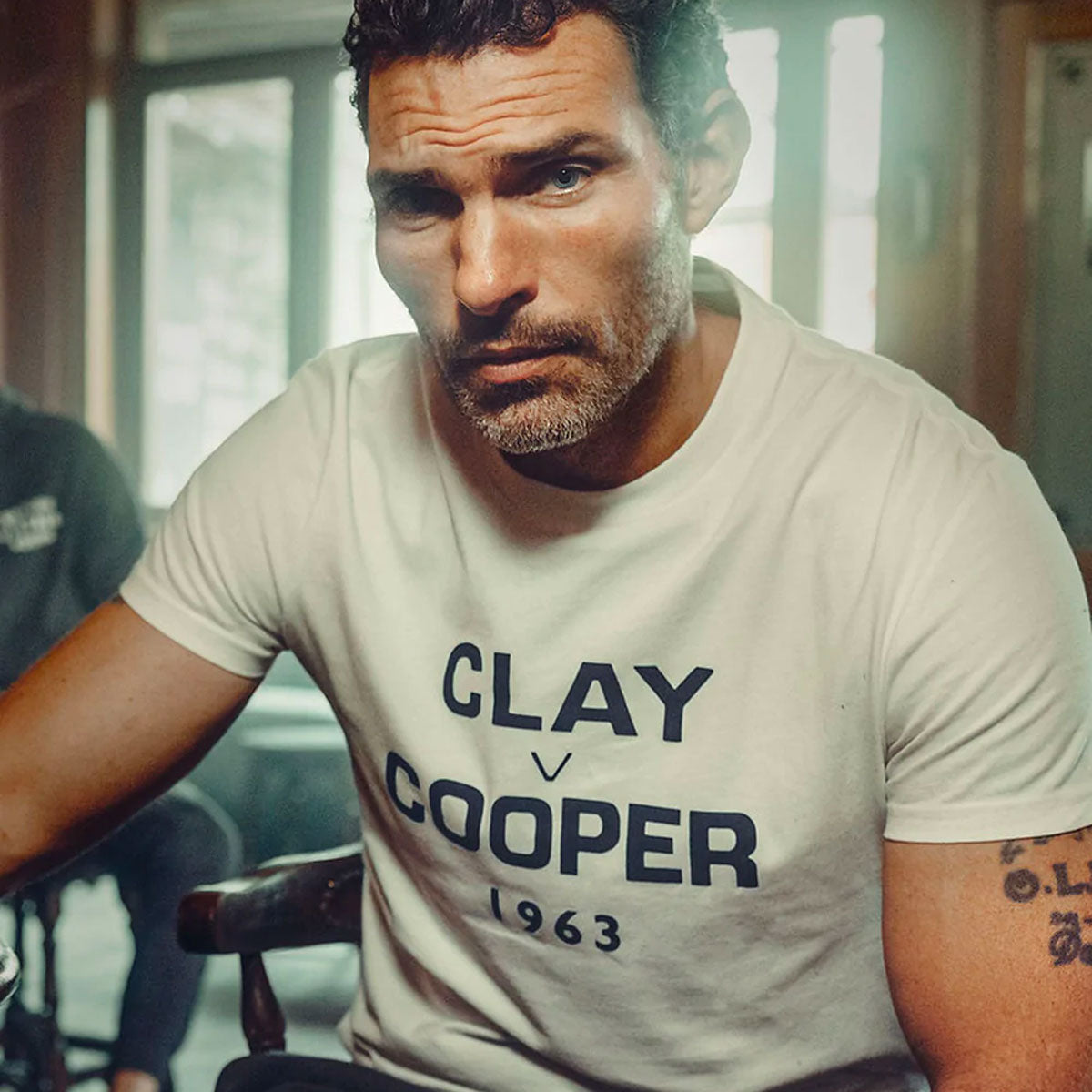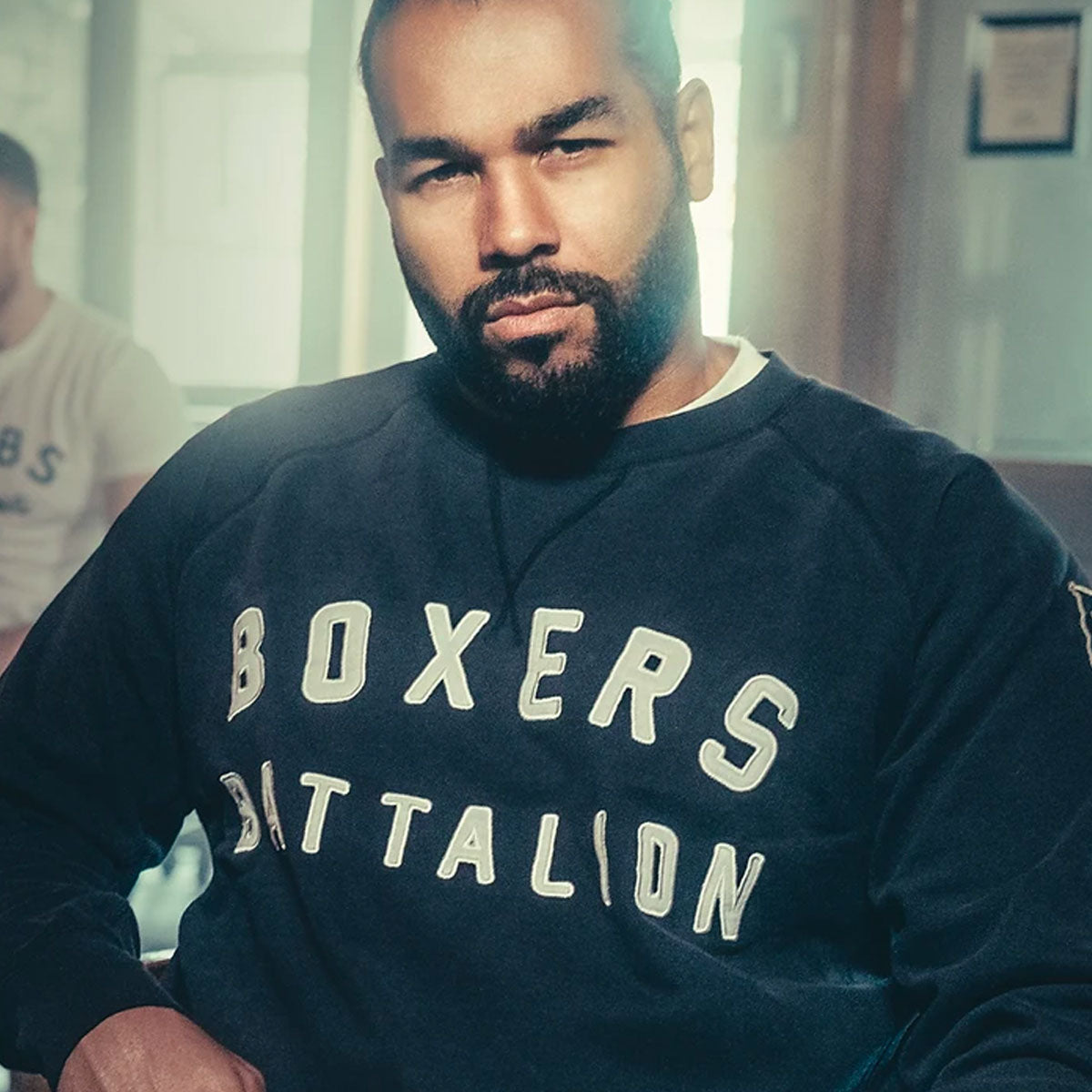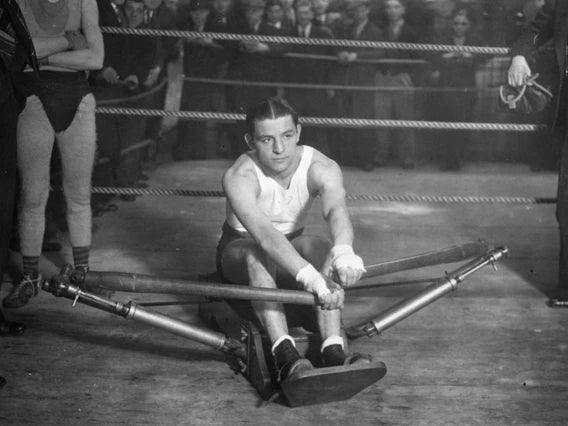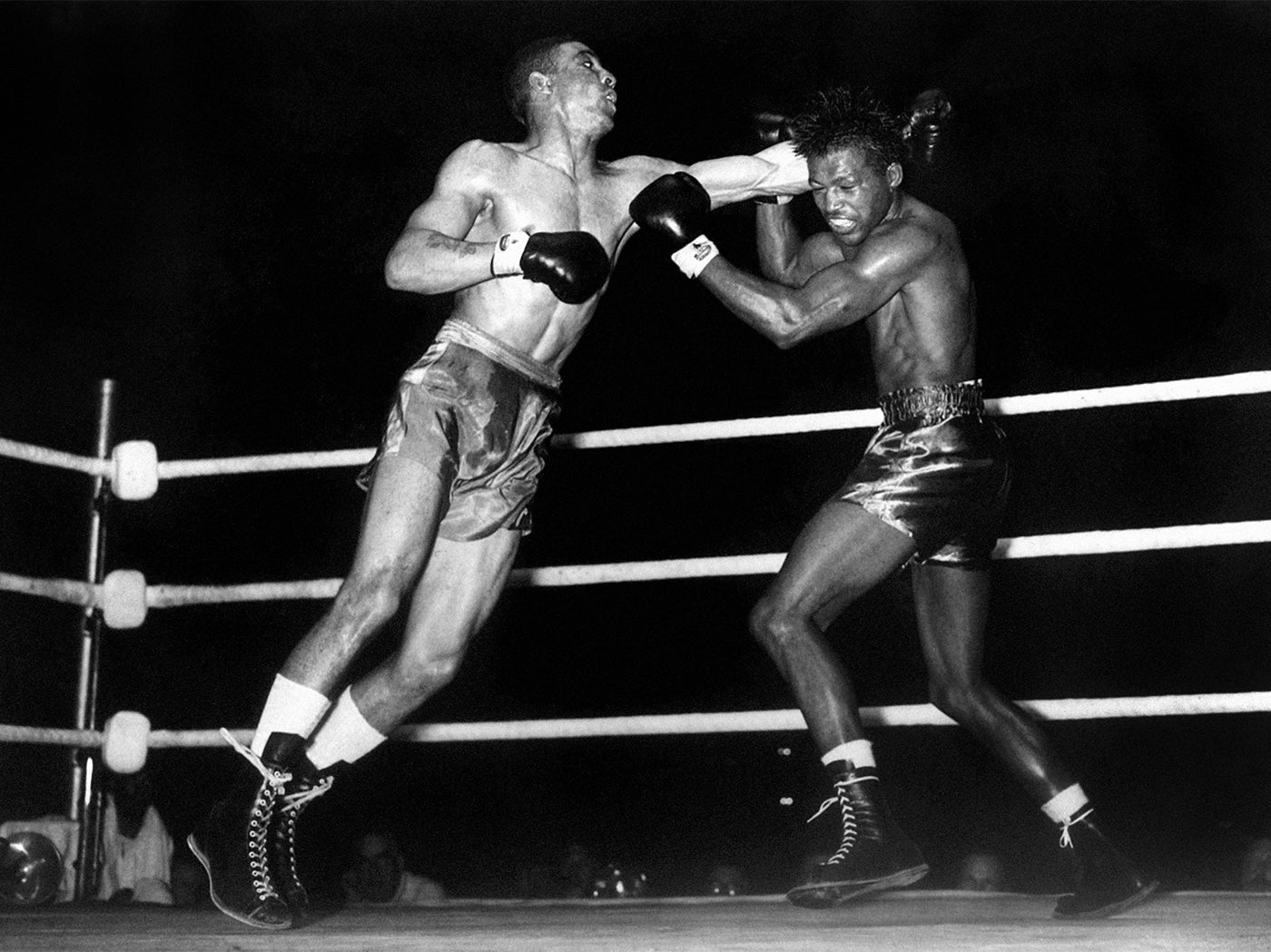By Paul Zanon
“He fought like a Tiger. He just tore into anyone. People loved that.” Harry Carpenter
Murder or suicide? These are often the first questions people mention when Freddie Mills comes up in conversation. However, there was a great deal more to the man than simply a shady backstory and a fantastic wardrobe.
Born on 26 June 1919 to Thomas James Mills a scrapyard merchant and initially bred in Bournemouth, Mills was the youngest of four children. After leaving school at 14 years of age he turned his hand to gardening, then had a go as a milkman’s assistant. However, something far more adrenaline fuelled attracted young Fredrick.
Older brother Charlie was a key inspiration to Freddie. As a young child he looked up to him and it wasn’t long before he donned the gloves himself, taking part in impromptu sparring session with Charlie at the back of the garden.
From garden sheds to boxing booths, young Freddie relished the opportunity to engage in a tear-up and bag a few shillings for his trouble and by 16 years of age he kicked off his professional boxing career in explosive form. On 26 February 1936 at Westover Ice Rink Mills knocked out fellow debutant and Dorset resident Jim Riley in the first round. The teenage super welterweight soon picked up the moniker of ‘The Bournemouth Bombshell,’ with his windmilling style, willing to tackle the most fearsome fighters at the drop of a hat. What many fail to remember is that he also had a great boxing brain and was on occasions a defensive genius, fighting behind his left shoulder long before Floyd Mayweather Jr was boasting the technique. The combination of brains, power and raw grit would pay dividends down the line.
Despite disposing of his next two opponents in sharp fashion, in his next three outings, Mills suffered a stoppage defeat to Eddie Gill, followed by two draws with Stan Nelson and George Hesketh. His record after three months read 3-2-1, which was hardly attention grabbing. However, an innate fire burned in his stomach to impress the onlooker and impress he did. In his next fight he fought Jack Scott…….twice on the same night. After knocking Scott out in the first round, the crowd were not happy with the result, so, they went at it again later shortly after, with Mills repeating the first round stoppage. 
After a 13 fight winning streak, Mills hit a few speed bumps. In his next eight fights he won three, lost three and drew two, albeit against albeit against experienced fighters who added to his learning curve. Incidentally, he set the record straight with all but one fighter from these losses and draws within the next three months.
As Britain officially threw its hit into the battlefield on 1 September 1939 after Hitler invaded Poland, Mills, eager to serve king and country in World War II joined the RAF in January 1940 and soon progressed to corporal physical training instructor. The 20-year-old, now a fully-fledged middleweight boasted a record of 44-9-6. Despite the losses and draws, Mills was a big attraction with his all-action style and when veteran Lancashire legend Jock McAvoy was lined up on 8 August 1940, all eyes were on the younger man.
After 12 rounds Mills walked away from the ‘The Stadium’ in Liverpool with a solid points victory over McAvoy, elevating his profile in boxing circles and his popularity with the ladies. Having previously been managed by Bob Turner, in 1941 he switched to Ted Broadribb and shortly after started having an affair with his daughter Chrissie McCorkindale, who was already married to Don McCorkindale. Mills and Chrissie eventually married in 1948 and stayed together until Mills’ death, albeit he was known to have had affairs during that period. Incredibly, Mills remained good friends with Don and treated Chrissie and Don’s son, also called Don, as his own.
Back to the boxing. Mills won 10 out of his next 12 contests before locking horns again with McAvoy. This time more was at stake. Serving now as a sergeant in the RAF, on 23 February 1942 Mills and McAvoy fight acted as a final eliminator for the British light heavyweight title. Unfortunately, despite the predicted barnburner at the Royal Albert Hall, McAvoy injured his back in the opening session and Mills was declared winner due to the retirement of his fistic foe. The victory did however propel Mills into his first big fight of note and the Dorset born destroyer didn’t fail to deliver a peak performance.
On 20 June 1942 at Tottenham FC’s football ground, Mills challenged Len Harvey for his British and Commonwealth light heavyweight titles in front of 30,000 fans. Fearless Freddie entered the ring at a rapid pace, no music or dilly dallying and with his dark robe simply initialled in large letters, ‘F M.’ Len, the champion followed moments later, walking quickly through the crowds in similar fashion and the moment he stepped through the ropes, shook Mills’ hands. The good old days when the focus was actually on the fighters and the fight. Not the sponsorship name, not the music track and certainly not the trash talking.
Harvey was without a doubt past his best and hadn’t fought in three years, but certainly didn’t come to make up the numbers. Unfortunately, for the Cornwall native, a combination of inactivity and father time paid its price as Mills steamrolled him from the opening chime, before knocking him clean out of the ropes in the opening minute of the second round. The first person to hug him as he clambered back into the ring was Mills. Harvey retired after this fight with an incredible record of 122-14-10. His story can be read here https://www.britishvintageboxing.com/post/len-harvey-move-on-up
In Mills’ next two fights he took on 6ft 4 ½ inch Yorkshireman Al Robinson, who weighed 217lbs. Mills weighed in between 170-175lbs most of his career, even though most of his opponents were much heavier and taller than his 5ft 10 ½ inch frame and Robinson was no different. In the first encounter Robinson retired and in the second he was knocked out in front of his home crowd in Leeds in under four minutes.
On 15 September 1944, Mills fought Jack London at the Kings Hall, Manchester who outweighed him by 43 lbs. They had fought three years prior over 10 rounds, with Mills clinching a points victory, but on this night, the heavier and more experienced London took victory over a 15 round points decision.
Jack London wins on points 1944
Five months later Mills stopped Scotland’s Ken Shaw in seven rounds, once again giving away over 30lbs in weight. A few months later he was sent to Burma and India with the army, but after 15 months he was demobilised in March 1946 and returned to the UK. Thankfully in Mills’ next fight, only one pound separated him and his opponent, which is a good thing as the world light heavyweight title was on the line.
Despite his father passing away in April 1946, on 14 May in front of 11,000 fans at the Harringay Arena, Freddie Mills challenged Gus Lesnevich for world honours. In the second round it looked like certain defeat for Mills after getting knocked down, then rising to his feet and getting hit with 13 unanswered punches. Inevitably, he went down again for a third time shortly after. These days that would have been game over. However, tenacious Mills rallied back, winning the fight from rounds 3-10 using his boxing skills. By the tenth session, in addition to a broken nose Lesnevich’s face was a bloody, swollen mess. Mills made the mistake of going for the kill in this round instead of cashing in on a certain points victory and was himself caught with a barrage similar to that in the second stanza. Moments after rising, Lesnevich clubbed him with an almighty right hand and the referee stopped the contest. The Ring Magazine commented: “Lesnevich floored Mills twice in the second round and twice again the 10th, before the referee stopped the fight. In between these two rough rounds, Freddie did extremely well. "This (was) one of the greatest fights in the history of British boxing."
Astonishingly, and perhaps stupidly, Mills was back in the ring at the same venue only three weeks later against heavyweight slugger, Bruce Woodcock. Bearing in mind the pounding Mills took in his previous fight and the short distance of time elapsed, that was pure madness and should never have gone ahead, especially against someone with Woodcock’s arsenal. Either way, despite hitting the canvas in the fourth round, Mills lasted the distance of a one sided pounding.
Two fights later, yet again Mills was the victim of bad matchmaking, sharing the ring with heavyweight, Joe Baksi. The New York slugger had shared the ring with good company, including lasting the distance with Jersey Joe Walcott, beating Lee Savold twice and would go on to stop Woodcock in seven rounds shortly after his encounter with Mills. The Dorset destroyer tried his best but in the end couldn’t come out for the sixth round. 
Joe Baksi and Freddie Mills post fight 1946
In other news around this time, Mills opened a Chinese restaurant which he co-owned with Chinese actor Andy Ho in the heart of Central London at 143 Charring Cross Road. He had also invested in various residential and commercial properties, not all of which paid dividends.
Four fights after Baksi, on 8 September 1947 Mills fought Pol Goffaux for the European light heavyweight title, forcing the Belgian to retire in the fourth round. Then, despite many saying Mills was washed up, 26 months after first challenging Lesnevich for his world title, the Bournemouth born boxer challenged the American once again for his title, but this time in front of a much bigger crowd at White City Stadium, West London.
On 26 July 1948 Lesnevich came out expecting to annihilate underdog Mills, but it was in fact him who was on the receiving end of the beating, narrowly making it through the first round after hitting the deck twice and once again displaying lacerations over both eyes. The Sydney Morning Herald wrote, ‘Blood streamed from cuts over both of Lesnevich's eyes from the 1st round and he was twice down for counts of nine, one of which he took resting on one knee.’ Controlling the fight behind a skilful and dominating performance, Mills became the first world light heavyweight champion in 45 years from Britain and incredibly, he achieved this feat in his 98th fight.

Freddie Mills wins the world light-heavyweight title
On 2 June 1949 at White City Stadium, Mills fought old foe Bruce Woodcock for the British, Commonwealth and European heavyweight titles. Giving away 20lbs to the natural heavyweight, Mills put up a brave fight, hitting the canvas in the first, fourth, eight and tenth rounds, before being knocked out in the twelfth. 
Mills’ last fight was on 24 January 1950 at the Earls Court Empress Hall, Kensington, when he put his world light heavyweight crown on the line against Giuseppe Antonio Berardinelli, better known as Joey Maxim. In addition to losing his title in the tenth round, Mills also lost most of the top row of his teeth against a very tough fighter who would continue to mix it with the very best in the coming years.
Fredrick Percival Mills fought 101 contests, with 77 victories (55 KO’s), 18 losses, six draws and retired at the age of 30. He became British, Commonwealth, European and World light heavyweight champion and was unphased by the height, weight or pedigree in front of him. He remains one of Britain’s most loved crowd pleasers.
Very shortly after retirement Mills was granted his manager’s license by the British Boxing Board of Control, then became a promoter and even started training fighters for a short time. He also released his autobiography entitled, ‘Twenty Years.’
Mills was a natural showman in front of the camera, with or without gloves and post retirement embraced a number of acting roles, including starring in a couple of ‘Carry On’ films and hosting the music show Six-Five. He also converted his Chinese restaurant into a nightclub in the early 60’s, at a time several gangs were roaming Central London, including the Richardsons and the Krays. The latter, who also hailed from boxing heritage, idolised Mills because of his achievements in the ring, however, such associations cast doubt as to whether this led his eventual demise and possible murder.
Around the time ‘Freddie Mills Nite Spot’ emerged, someone stole his world title belt from his car. Once the robber found out who it belonged to and no doubt who he was associated with, the strap was returned a few days later along with a note of apology for the theft.
Unfortunately the nightclub started going into financial ruin and its reputation had also been tarnished by allegations of the hostesses also being prostitutes. Rumour has it that Mills wanted the club to originally be a venue for families to get together and share good food and drink around a table, but instead he was forced to turn a blind eye to prostitution. Despite wanting to sell the business and step aside, he wasn’t given the portal of opportunity by whoever and for whatever reasons.
Around the corner from the club was Goslett Yard and on a number of occasions Mills would drive round there to catch 40 winks and recharge his batteries for the evening. This occasion turned out to be his last nap. He was found by a doorman shortly before midnight on 24 July 1965 sitting on his own in his pristine silver-grey Citroen DS19 sports car with a bullet through his right eye and a small calibre rifle resting next to his legs. He was officially pronounced dead on 25 July, aged 46.

The funeral was held at St Giles church, Camberwell and was widely attended. His pallbearers included Henry Cooper, Jack Solomons and Bruce Forsyth, who also read the eulogy.
With very little to substantiate, the verdict was ruled as suicide, which Mills’ family never accepted. The rifle had apparently been sourced from a friend at the fairground and apparently didn’t even function properly. The coroners report also said that Mills eyes were wide open at the time of being shot, which was not in keeping with suicide attempts as the person usually closes their eyes. The coroner believed he was looking at the gun, but someone else pulled the trigger. Theory two is that as he was sleeping someone came over to the opposite car window and shot him, then placed the rifle in the car. At the scene, an ambulance took his dead body away before police had arrived, which was strange as he was obviously dead and his body was part of the murder scene.
Suicide, Gang involvement and debt to crime syndicates are all in the melting pot of theories surrounding the death of Freddie Mills to this very day. However, one thing is for sure – Freddie Mills boxing credentials will always remain clearly intact. In the ring, he did himself proud.
Paul Zanon, has had 11 books published, with almost all of them reaching the No1 Bestselling spot in their respective categories on Amazon. He has co-hosted boxing shows on Talk Sport, been a pundit on London Live, Boxnation and has contributed to a number of boxing publications, including, Boxing Monthly, The Ring, Daily Sport, Boxing News, Boxing Social, amongst other publications.






